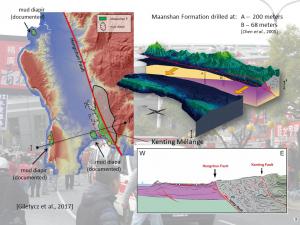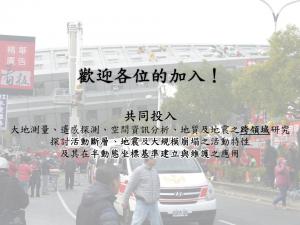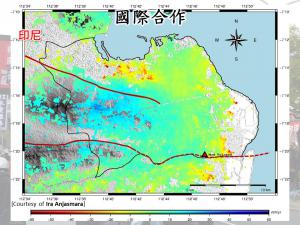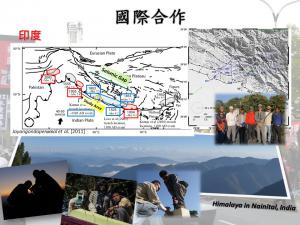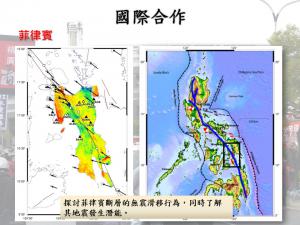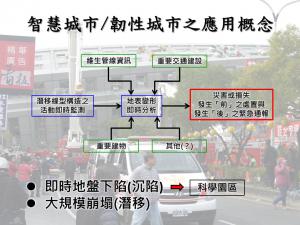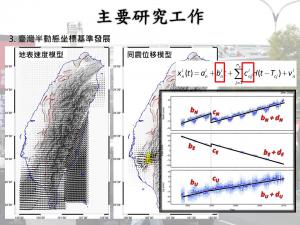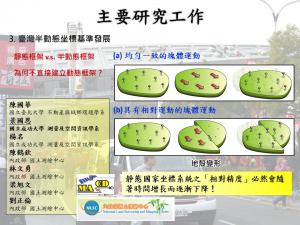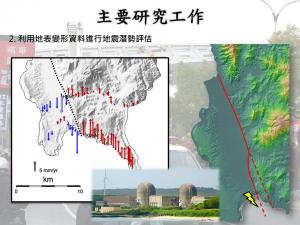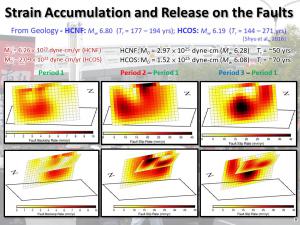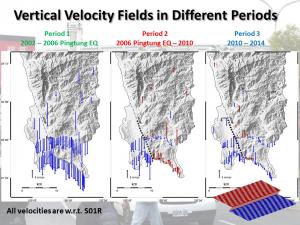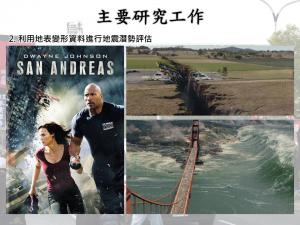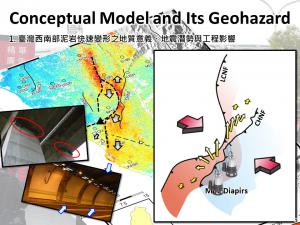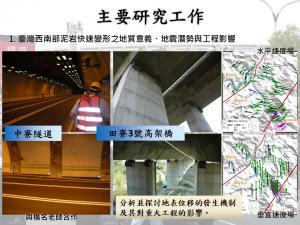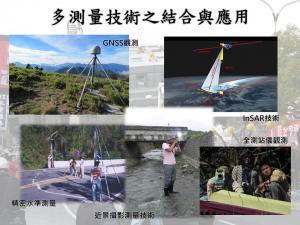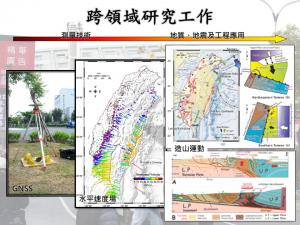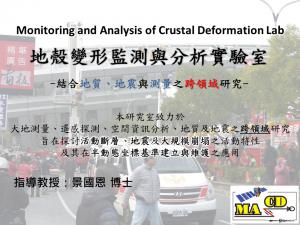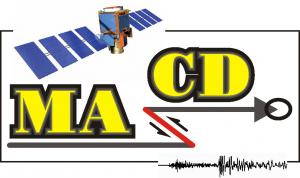
| Email: | jingkuen@mail.ncku.edu.tw |
| Email2: | kuenmiao@yahoo.com.tw |
| 電話: | 06-2757575 ext.63840 |
| 傳真: | 06-2375764 |
| 辦公室/研究室: | 55314 |
| 學歷: | Ph.D. Department of Earth Sciences, NCKU, Taiwan Sep. 2001 – Dec. 2007 B.S. Department of Earth Sciences, NCKU, Taiwan Sep. 1997 – Jun. 2001 |
| 經歷: | Aug. 2024 – now Professor Department of Geomatics, NCKU, Taiwan Feb. 2016 – Jul. 2024 Associate Professor Department of Geomatics, NCKU, Taiwan Feb. 2011 – Jan. 2016 Assistant Professor Department of Geomatics, NCKU, Taiwan Aug. 2010 – Jan. 2011 Postdoctoral fellow Institute of Earth Sciences, Academia Sinica, Taiwan Aug. 2009 – Jul. 2010 Postdoctoral researcher Department of Geological Sciences, Indiana University, USA Feb. 2008 – Jul. 2008 Postdoctoral researcher Department of Earth Sciences, NCKU, Taiwan |
| 專長: | 1. 地殼變形分析 (Crustal Deformation) 2. 地震潛能評估 (Earthquake Potential Estimation) 3. 泥貫入體研究 (Mobile shale) 4. 半動態框架 (Semi-Kinematic Geodetic Reference Frame) 5. 地層下陷 (Land Subsidence) |
| 授課項目: | 1. 地球物理概論 (Introduction to Geophysics) 2. 地質災害及其測量技術應用 (Geological disasters and their related geodetic technology) 3. Application of Geodetic Techniques to Crustal Deformation (大地測量技術在地殼變形研究之應用) |
| 個人網站: | https://researchoutput.ncku.edu.tw/zh/persons/kuo-en-ching |
Dr. Kuo-En Ching works in the field of crustal deformation using geodetic observations, with researches mainly focus on earthquake-related deformation analysis, creeping fault, mobile shale/mud volcano, seismic hazard assessment, volcanic deformation, construction of the semi-dynamic geodetic datum in Taiwan and land subsidence. His major study areas are Taiwan, Leyte in Philippines, Indian Himalaya, and Java in Indonesia. The geodetic data used in his studies include GNSS, precise leveling, traverse and InSAR. He obtained his Ph.D. in Crustal Deformation in Natioanl Cheng Kung University, Taiwan in 2007. He worked in Department of Earth Sciences, National Cheng Kung University for half a year as a Postdoctoral Fellow in 2008 before his military service. Next, he worked in Department of Geological Sciences, Indiana University, USA as a Postdoctoral Researcher during Aug. 2009-Jul. 2010. After he worked in Institute of Earth Sciences, Academia Sinica, Taiwan as a Postdoctoral Fellow during Aug. 2010-Jan. 2011, he accepted a Assistant Professor position at Department of Geomatics, National Cheng Kung University and was promoted to Associate Professor in 2016.
景國恩老師的工作是以地殼變形研究為主,也就是透過對GNSS、精密水準、導線測量與合成孔徑干涉雷達技術等測地資料的分析,整合地質與地球物理等空間資料的研究成果,透過電腦數值模擬的方式,探討造成固態地球變動的機制、原因,並將之應用到防災與測量領域的工作中。目前具體的研究工作包含了(1) 與地震相關之地殼變形分析;(2) 斷層活動性分析;(3) 潛移斷層特性研究;(4) 泥貫入體/泥火山活動分析;(5) 地震潛勢評估;(6) 臺灣半動態基準之建立;(7) 地層下陷分析。研究區域以臺灣、菲律賓的萊特島、印度喜馬拉雅山地區與印尼爪哇島為主。
A. SCI papers
- Huang, M.-H., J.-C. Hu, C.-S. Hsieh, K.-E. Ching, R.-J. Rau, E. Pathier, B. Fruneau, and B. Deffontaines (2006), A growing structure near the deformation front in SW Taiwan as deduced from SAR interferometry and geodetic observation, Geophys. Res. Lett., 33, L12305, doi:10.1029/2005GL025613 (SCI).
- Ching, K.-E., R.-J. Rau, and Y. Zeng (2007), Coseismic source model of the 2003 Mw 6.8 Chengkung earthquake, Taiwan, determined from GPS measurements, J. Geophys. Res., 112, B06422, doi:10.1029/2006JB004439 (SCI). 被獲選刊登至「成大研發快訊,第三卷,第二期,2008」
- Ching, K.-E., R.-J. Rau, J.-C. Lee, and J-C Hu (2007), Contemporary deformation of tectonic escape in SW Taiwan from GPS observations, 1995-2005, Earth Planet. Sci. Lett., 262, 601-619 (SCI). 被獲選刊登至「成大研發快訊,第六卷,第四期,2008」
- Rau, R.-J., K. H. Chen, and K.-E. Ching (2007), Repeating earthquakes and seismic potential along the northern Longitudinal Valley fault of eastern Taiwan, Geophys. Res. Lett., 34, L24301, doi:10.1029/2007GL031622 (SCI).
- Chen, Y.-G., Y.-T. Kuo, Y.-M. Wu, H.-L. Chen, C.-H. Chang, R.-Y. Chen, P.-W. Lo, K.-E. Ching, and J.-C. Lee (2007), New seismogenic source and deep structures revealed by the 1999 Chia-yi earthquake sequence in southwestern Taiwan, Geophys. J. Int., 172, 1049-1054 (SCI).
- Lee, Y.-H., G.-T. Chen, R.-J. Rau, and K.-E. Ching (2008), Coseismic displacement and tectonic implication of 1951 Longitudinal Valley earthquake sequence, eastern Taiwan, J. Geophys. Res., 113, B04305, doi:10.1029/2007JB005180 (SCI).
- Rau, R.-J., K.-E. Ching, J.-C. Hu, and J.-C. Lee (2008), Crustal deformation and block kinematics in transition from collision to subduction: GPS measurements in northern Taiwan, 1995-2005, J. Geophys. Res., 113, B09404, doi:10.1029/ 2007JB005414 (SCI).
- Huang, M.-H., J.-C. Hu, K.-E. Ching, R.-J. Rau, C.-S. Hsieh, E. Pathier, B. Fruneau, and B. Deffontaines (2009), Active deformation of Tainan Tableland of southwestern Taiwan based on geodetic measurements and SAR interferometry, Tectonophysics, 466, 322-334 (SCI).
- Hou, C.-S., J.-C. Hu, K.-E. Ching, Y.-G. Chen, C.-L. Chen, L.-W. Cheng, C.-L. Tang, S.-H. Huang, and C.-H. Lo (2009), The crustal deformation of the Ilan Plain acted as a westernmost extension of the Okinawa Trough, Tectonophysics, 466, 344-355 (SCI).
- Lin, K.-C., J.-C. Hu, K.-E. Ching, J. Angelier, R.-J. Rau, S.-B. Yu, C.-H. Tsai, T.-C. Shin, and M.-H. Huang (2010), GPS crustal deformation, strain rate and seismic activity after the 1999 Chi-Chi earthquake in Taiwan, J. Geophys. Res., 115, doi:10.1029/2009JB006417 (SCI).
- Ching, K.-E., K. M. Johnson, R.-J. Rau, R. Y. Chuang, L.-C. Kuo, and P.-L. Leu (2011), Inferred fault geometry and slip distribution of the 2010 Jiashian, Taiwan, earthquake is consistent with a thick-skinned deformation model, Earth Planet. Sci. Lett., 301, 78-86 (SCI).
- Chen, K.-H., M. Yang, Y.-T. Huang, K.-E. Ching, and R.-J. Rau (2011), Vertical displacement rate field of Taiwan from geodetic levelling data 2000-2008, Surv. Rev., 43, 296-302 (SCI).
- Ching, K.-E., M.-L. Hsieh, K. M. Johnson, K.-H. Chen, R.-J. Rau, and M. Yang (2011), Modern vertical deformation rates and mountain building in Taiwan from precise leveling measurements and continuous GPS observations, 2000-2008, J. Geophys. Res., 116, B08406, doi:10.1029/2011JB008242 (SCI).
- Ching, K.-E., R.-J. Rau, K. M. Johnson, J.-C. Hu, and J.-C. Lee (2011), Present-day kinematics of active mountain building in Taiwan from GPS observations during 1995-2005, J. Geophys. Res., 116, B09405, doi:10.1029/2010JB008058 (SCI).
- Rau, R.-J., J.-C. Lee, K.-E. Ching, Y.-H. Lee, T. B. Byrne, and R.-Y. Chen (2012), Subduction-continent collision in southwestern Taiwan and the 2010 Jiashian earthquake sequence, Tectonophysics, 578, 107-116 (SCI).
- Chuang, R. Y., K. M. Johnson, Y.-M. Wu, K.-E. Ching, and L.-C. Kuo (2013), A midcrustal ramp-fault structure beneath the Taiwan tectonic wedge illuminated by the 2013 Nantou earthquake series, Geophys. Res. Lett., 40, 5080-5084 (SCI).
- Hsieh, M.-L., K.-E. Ching, S.-J. Chyi, S.-C. Kang, and C. Y. Chou (2014), Late Quaternary mass-wasting records in the actively uplifting Pa-chang catchment, southwestern Taiwan, Geomorphology, 216, 125-140 (SCI).
- Wen, Y.-Y., H. Miyake, Y.-T. Yen, K. Irikura, and K.-E. Ching (2014), Rupture directivity effect and stress heterogeneity of the 2013 Nantou blind-thrust earthquakes, Taiwan, Bull. Seismol. Soc. Amer., 104 (6), 2933-2942, doi: 10.1785/0120140109 (SCI).
- Ching, K.-E. and K.-H. Chen (2015), Tectonic effect for establishing a semi-dynamic datum in Southwest Taiwan, Earth Planets Space, 67, DOI 10.1186/s40623-015-0374-0 (SCI).
- Chang, W.-L., K.-E. Ching, C.-H. Lee, Y.-R. Lee, and C.-F. Lee (2016), Earthquake potential of active faults in Taiwan from GPS observations and block modeling, Seismol. Res. Lett., 87, doi:10.1785/0220160094 (SCI).
- Ching, K.-E., J. R. Gourley, Y.-H. Lee, S.-C. Hsu, K.-H. Chen, and C.-L. Chen (2016), Rapid deformation rates due to development of diapiric anticline in southwestern Taiwan from geodetic observations, Tectonophysics, 692, 241-251 (SCI).
- Tung, H., H.-Y. Chen, J.-C. Hu, K.-E. Ching, H. Chen, K.-H. Yang (2016), Transient deformation induced by groundwater change in Taipei metropolitan area revealed by high resolution X-band SAR interferometry, Tectonophysics, 692, 265-277 (SCI).
- Rateb, A., C.-Y. Kuo, M. Imani, K.-H. Tseng, and K.-E. Ching (2017), Terrestrial Water Storage in African Hydrological Regimes Derived from GRACE Mission: Intercomparison of the Spherical Harmonics, Mass Concentration, and Scalar Slepian Methods, Sensors, 17, 566, doi: 10.3390/s17030566 (SCI).
- Chao, K., Z. Peng, Y.-J. Hsu, K. Obara, C. Wu, K.-E. Ching, S. van der Lee, H.-C. Pu, P.-L. Leu, and A. Wech (2017), Temporal variation of tectonic tremor activity in southern Taiwan around the 2010 ML6.4 Jiashian earthquake, J. Geophys. Res., 122, doi:10.1002/2016JB013925 (SCI).
- Rateb, A., K.-E. Ching, C.-Y. Kuo, R.-J. Rau, and C. L. Chen (2017), Kinematics of the tectonic blocks and active faults at the post-orogenic stage: Northern Taiwan, J. Asian Earth Sci., 149, 29-40 (SCI).
- Le Béon, M., M.-H. Huang, J. Suppe, S.-T. Huang, E. Pathier, W.-J. Huang, C.-L. Chen, B. Fruneau, S. Baize, K.-E. Ching, and J.-C. Hu (2017), Shallow geological structures triggered during the Mw6.4 Meinong earthquake, southwestern Taiwan, Terr. Atmos. Ocean. Sci., 28, 663-681, DOI: 10.3319/TAO.2017.03.20.02 (SCI).
- Giletycz, S., C.-P. Chang, A. T.-S. Lin, K.-E. Ching, and J. B. H. Shyu (2017), Improved alignment of the Hengchun Fault (southern Taiwan) based on fieldwork, Structure-from-Motion, shallow drilling, and levelling data, Tectonophysics, 721, 435-447 (SCI).
- Kao, R., C. Hwang, J. W. Kim, K.-E. Ching, F. Masson, W.-C. Hsieh, N. Le Moigne, and C.-C. Cheng (2017), Absolute gravity change in Taiwan: Present result of geodynamic process investigation, Terr. Atmos. Ocean. Sci., 28, 855-875, DOI: 10.3319/TAO.2017.06.13.01 (SCI).
- Yhokha, A., P. K Goswami, C.-P. Chang, J.-Y. Yen, K.-E. Ching, and K M. Aruche (2018), Application of Persistent Scatterer Interferometry (PSI) in monitoring slope movements in Nainital, Uttarakhand Lesser Himalaya, India, J. Earth Syst. Sci., 127, DOI: 10.1007/s12040-017-0907-y (SCI).
- Lee, C.-M., C.-Y. Kuo, J. Sun, T.-P. Tseng, K.-H. Chen, W.-H. Lan, C. K. Shum, T. Ali, K.-E. Ching, P. Chu, and Y. Jia (2018), Evaluation and Improvement of Coastal GNSS Reflectometry Sea Level Variations from Existing GNSS Stations in Taiwan, Advances in Space Research, Accepted, doi: https://doi.org/10.1016/j.asr.2018.10.039 (SCI)..
- Li, C.-K., K.-E. Ching, and K.-H. Chen (2019), The ongoing modernization of the Taiwan semi-dynamic datum based on the surface horizontal deformation model using GNSS data from 2000 to 2016, J. Geodesy, https://doi.org/10.1007/s00190-019-01267-5 (SCI).
- Wen, Y.-Y., S. Wen, Y.-H. Lee, and K.-E. Ching (2018), The kinematic source analysis for 2018 Mw 6.4 Hualien, Taiwan earthquake, Terr. Atmos. Ocean. Sci., 30, 377-387, doi: 10.3319/TAO.2018.11.15.03 (SCI).
- Wen, S., Y.-Y. Wen, K.-E. Ching, Y.-L. Yeh, and Y.-H. Lee (2019), Tectonic Implications on the 2018 Hualien Earthquake, Terr. Atmos. Ocean. Sci. 30, 389-398, DOI: 10.3319/TAO.2019.01.28.01 (SCI).
- Chen, K.-H., R. Y. Chuang, and K.-E. Ching (2020), Realization approach of non‑linear postseismic deformation model for Taiwan semi‑kinematic reference frame, Earth Planets Space, 72, https://doi.org/10.1186/s40623-020-01209-y (SCI)
- Sharma, Y., S. Pasari, K.-E. Ching, O. Dikshit, T. Kato, J. N. Malik, C.-P. Chang, and J.-Y. Yen (2020), Spatial distribution of earthquake potential along the Himalayan arc, Tectonophysics, 791, https://doi.org/10.1016/j.tecto.2020.228556 (SCI).
- Wen, Y.-Y., Y.-T. Yen, C.-H. Kuo, and K.-E. Ching (2020), Source and strong-motion characteristics of two M > 6 buried earthquakes in southwest Taiwan, Earth Planets Space, 72, 188 (2020). https://doi.org/10.1186/s40623-020-01322-y (SCI)
- Zhao, X., Z. Wen, J. Xie, Q. Xie, and K.-E. Ching (2021), Comparison of near-fault velocity pulse-like ground motions from the 2018 Mw 6.4 Hualien, Taiwan, earthquake with the Next Generation Attenuation (NGA)-West2 ground motion models and directivity models, Bull. Seismol. Soc. Amer., doi: https://doi.org/10.1785/0120200141 (SCI)
- Hsiao, S.-H., K.-E. Ching, K.-H. Chen, and C.-K. Li (2021), Timing of coseismic displacement grid model construction for updating the semi-kinematic reference frame: Case study in Taiwan, J. Geodesy, 95, 25, https://doi.org/10.1007/s00190-021-01477-w (SCI)
- Rau, R.-J., Y.-Y. Wen, K.-E. Ching, M.-C. Hsieh, Y.-T. Lo, C.-Y. Chiu, and M. Hashimoto (2022), Origin of coseismic anelastic deformation during the 2016 Mw 6.4 Meinong Earthquake, Taiwan, Tectonophysics, 836, 229428, https://doi.org/10.1016/j.tecto.2022.229428 (SCI)
- Lo, Y.-T., K.-E. Ching, H.-Y. Yen, S.-C. Chen (2023), Bouguer gravity anomalies and the three-dimensional density structure of a thick mudstone area: A case study of southwestern Taiwan, Tectonophysics, 848, 229730, https://doi.org/10.1016/j.tecto.2023.229730 (SCI)
- Sharma, Y., S. Pasari, K.‑E. Ching, H. Verma, and, N. Choudhary (2023). Kinematics of crustal deformation along the central Himalaya, Acta Geophys., https://doi.org/10.1007/s11600-023-01175-5 (SCI).
- Sharma, Y., S. Pasari, K.‑E. Ching, H. Verma, T. Kato, and O. Dikshit (2023). Interseismic slip rate and fault geometry along the northwest Himalaya, Geophys. J. Int., 235, 2694-2706 (SCI).
- Alif, S. M., K.‑E. Ching, T. Sagiya, and W. N. Wahyuni (2024). Determination of Euler pole parameters for Sundaland plate based on updated GNSS observations in Sumatra, Indonesia, Geosci. Lett., 11:16, https://doi.org/10.1186/s40562-024-00330-0 (SCI).
- Lin, L. J., R. Y. Chuang, C.-H. Lu, K.-E. Ching, and C.-L. Chen (2024), Derivation of 3D coseismic displacement field from integrated azimuth and LOS displacements for the 2018 Hualien Earthquake, Remote Sens., 16, 1159. https://doi.org/10.3390/rs16071159 (SCI).
- Verma, H., Y. Sharma, K.‑E. Ching, S. Pasari (2024), Contemporary seismic moment budget along the Nepal Himalaya derived from high‑resolution InSAR and GPS velocity field, Acta Geophys., https://doi.org/10.1007/s11600-024-01411-6 (SCI).
- Le Béon, M., C.‑C. Chen, W.‑J. Huang, K.‑E. Ching, J.‑W. Shih, Y.‑C. Tseng, Y.‑W. Chiou, Y.‑C. Liu, M.‑L. Hsieh, E. Pathier, C.‑H. Lu, and B. Fruneau (2024), Aseismic deformation within fold‑and‑thrust belts: example from the Tsengwen River section of southwest Taiwan, Geosci. Lett., 11, 57, https://doi.org/10.1186/s40562-024-00373-3 (SCI).
- Lu, C.-H., R. C. Chuang, P.-C. Chiang, J.-Y. Yen, K.‑E. Ching, and Y.-G. Chen (2025), Detecting infrastructure hazard potential change by SAR techniques on postseismic surface deformation: A case study of 2016 Meinong earthquake in southwestern Taiwan, Eng. Geol., 344, 107827, https://doi.org/10.1016/j.enggeo.2024.107827 (SCI).
- Azeriansyah, R., K.‑E. Ching, C.-W. Lin, K.-C. Hsu, P.-C. Tsai, C.-L. Yeh, and R.-J. Rau (2025), Unraveling the heterogeneous hydrogeological characteristics in the Choushui River alluvial fan, Taiwan, through observations from the multi-layer compaction monitoring wells, Eng. Geol., 344, 107843, https://doi.org/10.1016/j.enggeo.2024.107843 (SCI).
- Wu, H.-Y., H.-C. Liu, L.-C. Kao, K.‑E. Ching, C.-C. Chen, C.-F. You, T.-C. Yi, Y.-H. Chen, B.-L. Wu, and C.-J. Chen (2025), Potential geological risks from mud diatremes in the orogen regime of Southwestern Taiwan, Sci. Rep., 15, 7666, https://doi.org/10.1038/s41598-025-91915-y (SCI).
- Lee, E.‑J., W.‑Y. Liao, P. Chen, R.‑J. Rau, Y.‑H. Lee, S. Wen, K.‑E. Ching, D.‑Y. Chen, and W.‑T. Liang (2025), Fast report: applying a weighted template‑matching algorithm (WTMA) to investigate the seismogenic structures and microseismic activity of the 2025 ML6.4 Dapu earthquake sequence in Taiwan, Terr. Atmos. Ocean. Sci., 36:9, https://doi.org/10.1007/s44195-025-00095-9 (SCI).
- Liao, W.‑Y., E.‑J. Lee, R.‑J. Rau, D.‑Y. Chen, S. Wen, K.‑E. Ching, and W.‑T. Liang (2025), Fast report: seismogenic structure of the 2025 M6.4 dapu earthquake sequence in western Taiwan revealed by a deep‑learning‑empowered earthquake catalog, Terr. Atmos. Ocean. Sci., 36:10, https://doi.org/10.1007/s44195-025-00093-x (SCI).
- Lee, Z., R. Y. Chuang, I-T. Wang, L. Chen, W.-L. Chang, C.-Y. Chiu, K.-E. Ching, S.-W. Guo, and C.-L. Chen (2025), Fast report: surface deformation associated with the 2025 Dapu earthquake, Terr. Atmos. Ocean. Sci., 36:11, https://doi.org/10.1007/s44195-025-00090-0 (SCI).
- Sharma, Y., K.-E. Ching, W.-L. Chang, H.-C. Chen, S.-H. Hsiao, W.-Y. Liao, E.-J. Lee, R. Y. Chuang, and C.-L. Chen (2025), Fast Report: Coseismic source model of the January 2025 Mw 6.1 Dapu earthquake from geodetic data and its implications for seismogenic structures in southwestern Taiwan, Terr. Atmos. Ocean. Sci., 36:18, https://doi.org/10.1007/s44195-025-00100-1 (SCI).
- Aleem, H., M. Béon, A. T.-S. Lin, K.-E. Ching, J. I. Soto, K.-F. Chen, and N.-T. Nguyen (2025), Structures in the active western foothills of southwestern Taiwan: Fault-related folding versus shale tectonics, Interpretation, 13, T327-T346 (SCI).
- Ishimaru, Y., Y. Takada, K.-E. Ching, and W.-L. Chang (2025), Strong Fault interaction in double-vergence structure: Lessons from the 2022 Yuli Earthquake and the 2022 Chihshang Earthquake, eastern Taiwan, J. Geophys. Res. Solid Earth, 130, e2025JB031225. https://doi.org/10.1029/2025JB031225 (SCI).
B. Non SCI papers
- 饒瑞鈞、景國恩、謝宗訓、余致義、侯進雄、李元希、胡植慶、詹瑜璋、李建成、洪日豪、林啟文(2003),台南台地的地表變形與地震潛能,經濟部中央地質調查所特刊,第十四號,第147-156頁。
- 蔡旻穎、景國恩、陳鶴欽、饒瑞鈞(2007),台灣GPS連續觀測站坐標時間序列分析方法研究,地籍測量,第廿六卷,第1-24頁。
- 郭素妙、景國恩、饒瑞鈞、侯進雄(2008),由1996-2006年之GPS資料探討台南地區地殼變形,經濟部中央地質調查所特刊,第二十號,第1-16頁。
- 景國恩、饒瑞鈞、李建成、胡植慶、侯進雄(2008),由1995-2005年之GPS觀測資料探討台灣西南部之地殼變形,經濟部中央地質調查所特刊,第二十號,第17-31頁。
- 周侑德、景國恩、饒瑞鈞、劉啟清(2008),精密水準觀測之資料品質及精度分析,經濟部中央地質調查所特刊,第二十號,第49-62頁。
- 莊舒雲、陳鶴欽、景國恩、饒瑞鈞、侯進雄(2008),由1996-2006年之GPS觀測資料看台灣中部地區集集地震前後之地殼變形,經濟部中央地質調查所特刊,第二十號,第63-80頁。
- 楊佳勳、景國恩、饒瑞鈞、陳江鑫、侯進雄(2008),由1995至2006年之GPS觀測資料探討潮州斷層與恆春斷層之活動行為,經濟部中央地質調查所特刊,第二十號,第81-96頁。
- 邱詠恬、景國恩、侯進雄、胡植慶、饒瑞鈞(2008),由2002-2006年之GPS觀測資料探討宜蘭平原之地殼變形,經濟部中央地質調查所特刊,第二十號,第111-124頁。
- 楊佳勳、陳江鑫、景國恩、饒瑞鈞(2012),利用2002-2010年GPS觀測資料探討臺灣西北部地表變形模式,經濟部中央地質調查所特刊,第二十六號,第267-287頁。
- 許書琴、景國恩、李元希、楊佳勳、饒瑞鈞、陳國華(2012),利用2002-2010年大地測量資料探討臺灣西南部泥岩區現今之地殼變形特性,經濟部中央地質調查所特刊,第二十六號,第241-265頁。
- 景國恩、許書琴、孔冠傑、陳芊如、趙荃敏(2013),台灣地區動態座標框架立之先期研究-台灣現今之地殼變形模式,國土測繪與空間資訊,第一卷,第99-117頁。
- 趙荃敏、景國恩、李寧、陳建良(2014),鳳山轉換斷層現今之活動行為及其地震潛能分析,國土測繪與空間資訊,第二卷,第107-129頁。
- 李劍珩、景國恩、張中白、饒瑞鈞、陳建良(2014),從 2002-2013 年大地測量資料探討 2006 屏東外海地震誘發恆春半島斷層活動之特性,經濟部中央地質調查所特刊,第二十八號,第197-221頁。
- 柯斯曼、景國恩、饒瑞鈞、陳建良(2014),利用2002-2013年GPS及水準資料探討梅山斷層之現今活動特性,經濟部中央地質調查所特刊,第二十八號,第234-240頁。
- 陳建良、江崇榮、林燕初、景國恩(2016),濁水溪沖積扇近期地表變形觀測,地籍測量,第35卷,第15-31頁。
- 景國恩、楊名、陳鶴欽、林文勇、梁旭文、劉正倫(2017),臺灣半動態基準之建立與展望,國土測繪與空間資訊,第5卷,第83-109頁。
- 楊名、景國恩、楊智堯、吳宗翰、吳文隆、蕭秋安(2018),廣域大地變位之利用GPS監測分析與解算─以國道3號田寮3號高架橋及中寮隧道大地變位監測為例,中華技術,第119期,第122-135頁。
- 陳江鑫、景國恩、饒瑞鈞、胡植慶、鄭凱謙、張午龍、莊昀叡、陳建良、陳鶴欽(2018),利用GNSS與精密水準資料解析臺灣地區2002年至2017年之地表變形型態,經濟部中央地質調查所特刊,第三十三號,第157-178頁。
- 趙荃敏、莊昀叡、景國恩、李易叡、陳建良(2018),利用BLOCKS塊體模型分析中部地區活動斷層滑移速率,經濟部中央地質調查所特刊,第三十三號,第179-195頁。
- 李秋賢、張午龍、景國恩、李易叡(2018),利用GPS觀測資料及塊體模型探討臺灣活斷層的震間行為,經濟部中央地質調查所彙刊,第三十一號,第87-115頁。
- 蕭詩涵、景國恩、陳國華、周逸屏、陳鶴欽、林文勇(2019),臺灣半動態基準地表變形模式精進研究–同震格點位移模型新增時機之探討,國土測繪與空間資訊,第7卷,第33-68頁。
- 景國恩、張午龍、邱紀瑜、胡植慶、陳建良、顏君毅(2019),利用大地測量資料探討2018年與2019年花蓮地震之震源特性,經濟部中央地質調查所特刊,第三十號,第145-159頁。
- 陳建良、劉彥求、景國恩、陳國華(2019),利用GPS連續站觀測龍船斷層鄰近地區地表變形情形,經濟部中央地質調查所特刊,第三十號,第157-176頁。
- 石晶瑩、景國恩、張午龍、莊昀叡、陳建良(2019),利用GNSS與精密水準資料解析臺灣中部地區之斷層滑移虧損速率,經濟部中央地質調查所彙刊,第三十二號,第45-63頁。
- 周逸屏、陳國華、景國恩、楊名、陳鶴欽(2020),臺灣衛星連續站坐標時間序列分析與平面坐標基準適用期之探討,台灣土地研究,第二十三卷,第83-101頁。
- 陳松春、景國恩、羅祐宗、陸挽中(2020),台南背斜及中洲背斜之泥貫入體特徵、活動性及地質安全,經濟部中央地質調查所彙刊,第三十三號,第1-32頁。
- 陳建良、景國恩、張午龍、莊昀叡、饒瑞鈞、胡植慶(2021),臺灣陸域33條活動斷層滑移速率之評估,臺灣地殼變形論文集,第4-25頁。
- 趙荃敏、莊昀叡、景國恩、李易叡(2021),利用BLOCKS塊體模型分析臺灣西南部地區活動斷層滑移速率,臺灣地殼變形論文集,第42-53頁。
- 李柏逸、景國恩、張午龍、蕭詩涵、石晶瑩、魯曜銓、饒瑞鈞、陳國華(2021),臺灣地區2006至2019年地表同震位移場目錄之建置,臺灣地殼變形論文集,第68-83頁。
- 張午龍、蕭立揚、景國恩、邱紀瑜、童忻、鄭凱謙、胡植慶(2021),利用GPS與InSAR觀測資料及塊體模型探討臺灣西南部活動斷層的震間行為,臺灣地殼變形論文集,第84-99頁。
- 石晶瑩、景國恩、饒瑞鈞、柯斯曼(2021),利用GNSS資料解析1906年梅山地震可能之孕震構造,臺灣地殼變形論文集,第116-127頁。
- 蕭詩涵、景國恩、蔡佩京、李劍珩、饒瑞鈞、陳國華(2021),利用測地資料估算恆春斷層之斷層滑移虧損速率,臺灣地殼變形論文集,第128-143頁。
- 蔡佩京、蕭詩涵、景國恩、盧志恆、顏君毅、邱紀瑜(2022),利用大地測量資料探討2022年長濱地震之震源特性,經濟部中央地質調查所彙刊,第三十五號,第133-146頁。
- 景國恩、陳松春、吳泓昱、蔡佩京、蕭詩涵、陳芊如(2023),臺南台地現今地殼變形機制爭議之初步探討及來自成大資源工程系教學井之暗示,土木水利,第五十卷,第二期,DOI: 10.6653/MoCICHE.202304_50(2).0000。
- 蕭震洋、莊伯禹、柯建仲、冀樹勇、景國恩(2023),以GNSS連續觀測站速度場溯源模擬臺灣地形演化史之可行性初探,中興工程,第159期,第39-51頁。
- Azeriansyah, R., K.-E. Ching, and B. D. Yuwono (2025), Impact of land subsidence-induced three-dimensional surface deformation on infrastructure in the Semarang-Demak Alluvial Plain, Indonesia, Journal of Earth and Marine Technology, 5,111-122.
C. International Conference Abstracts/Papers
- Ching, K., and R. Rau (2002), Seimicity and earthquake focal mechanisms near a collision boundary fault: the Chauchou fault, southern Taiwan, Eos Trans. AGU, 83(47), Fall Meet. Suppl., Abstract, T61B-1274.
- Chan, Y.-C., J.-C. Lee, C.-Y. Lu, H.-T. Chu, C.-S. Hou, R.-J. Rau, and K. E. Jing (2002). Neotectonic features adjacent the Chaochou fault in SW Taiwan: a case of active extension within compressive foreland region, Geological Society of China Abstracts with Programs.
- Chan, Y.-C., J.-C. Lee, C.-Y. Lu, H.-T. Chu, C.-S. Hou, R.-J. Rau, and K.-E. Ching (2002). Neotectonic and structural characteristics along the Chaochou fault system in SW Taiwan: implications for tectonic escape during oblique plate convergence. Eos Trans. AGU, 83(47), Fall Meet. Suppl., Abstract T61B-1274.
- Rau, R., K. Ching, T. Hsieh, C. Yu, C. Hou, Y. Lee, J. Hu, Y. Chan, J. Lee, J. Hung, and C. Lin (2003), Surface deformation and earthquake potential of Tainan tableland, southwestern Taiwan,Eos Trans. AGU, 84(46), Fall Meet. Suppl., Abstract, T11F-01.
- Ching K., J. Rau, and C. Hou (2003). Present-day crustal deformation across central-western Taiwan fold-and-thrust belt from GPS observations, 1996-1999 , Eos Trans. AGU, 84(46), Fall Meet. Suppl., Abstract T11F-03.
- Ching, K.-E., R.-J. Rau, and C.-S. Hou (2005), Lithospheric deformation of a young arc-continent collision orogen: GPS observations in south Taiwan, Geodynamics and Environment in East Asia International Conference & 5th Taiwan-France Earth Science Symposium.
- Ching, K.-E., and R.-J. Rau (2008) Kinematics of present-day interseismic deformation of Taiwan, International Conference of Arc-Continent Collision: IGCP Project 524.
- Ching, K.-E., R.-J. Rau, J.-C. Lee, and J.-C. Hu (2008), Present-day crustal deformation of Taiwan, International Workshop on Geodynamics of South-East Asia.
- Ching, K.-E., R.-J. Rau, J.-C. Hu, J.-C. Lee and K. Johnson (2009), Present-day Crustal Deformation of Taiwan, 2009 Southern California Earthquake Center Annul Meeting.
- Ching, K.-E., R.-J. Rau, J.-C. Hu, J.-C. Lee and K. Johnson (2009), Present-day Crustal Deformation of Taiwan, Eos Trans. AGU, 90(52), Fall Meet. Suppl., Abstract T21B-1808.
- Ching, K.-E., K. Johnson, H.-L. Chung and R.-J. Rau (2010), Frictional properties of the Chihshang fault, eastern Taiwan, inferred from postseismic slip following the 2003 Mw 6.8 Chengkung earthquake, Eos Trans. AGU, 91(26), West. Pac. Geophys. Meet. Suppl., Abstract T32A-06.
- Ching, K.-E., M.-L. Hsieh, K. Johnson, K.-H. Chen and R.-J. Rau (2010), Modern vertical deformation in Taiwan: Precise leveling measurements and continuous GPS observations, 2000-2008, Eos Trans. AGU, 91(26), West. Pac. Geophys. Meet. Suppl., Abstract G42A-06.
- Rau, R.-J., K.-E. Ching and K. Johnson (2010), Earthquake potential of the Hsinhua fault at the deformation front of southern Taiwan, Eos Trans. AGU, 91(26), West. Pac. Geophys. Meet. Suppl., Abstract T23A-085.
- Ching, K.-E., K. Johnson, H.-L. Chung, R.-J. Rau and J.-C. Lee (2010), Frictional properties of the Chihshang fault, eastern Taiwan, inferred from postseismic slip following the 2003 Mw 6.8 Chengkung earthquake, Eos Trans. AGU, Fall Meet. Suppl., Abstract T51F-05.
- Johnson, K. M., K.-E. Ching and R.-J. Rau (2010), Models of active mountain building in Taiwan constrained by GPS, leveling, geologic and stress observations, Eos Trans. AGU, Fall Meet. Suppl., Abstract G44A-07.
- Lee, J.-C., K.-E. Ching, J. Angelier, H.-C. Chu, J.-C. Hu and H.-Y. Chen (2010), Characterization of transient deformation near surface fault zone during an earthquake: A case study of the Chihshang fault in eastern Taiwan, Eos Trans. AGU, Fall Meet. Suppl., Abstract T23D-04.
- Hsu, S.-C. and K.-E. Ching (2011), Crustal deformation of the mud stone area in SW Taiwan using the geodetic data from 2002 to 2010, The 32nd Asian Conference on Remote Sensing.
- Hsu, S.-C. and K.-E. Ching (2011), Crustal deformation of the mud stone area in SW Taiwan using the geodetic data from 2002 to 2010, Eos Trans. AGU, Fall Meet. Suppl., Abstract T43D-2383.
- Yang, C.-H., K.-E. Ching, R.-J. Rau, C.-S. Chen (2011), Crustal deformation of a waning collision zone in NW Taiwan constrained by geodetic data during 2002-2010, Eos Trans. AGU, Fall Meet. Suppl., Abstract T43D-2384.
- Chen, K.-H. and K.-E. Ching (2011), Surface motion in the Western Coastal Plain of Taiwan after removal of groundwater withdrawal effects, Eos Trans. AGU, Fall Meet. Suppl., Abstract T43D-2385.
- Johnson, K. M. and K.-E. Ching (2011), Present-day mountain building in Taiwan: whole-crustal thickening, Eos Trans. AGU, Fall Meet. Suppl., Abstract T52C-01.
- Ching, K.-E., Y.-H. Lee, R.-J. Rau, J.-C. Hu, and S.-C. Hsu (2011), High earthquake potential across the Liuchia-Chukou fault area in SW Taiwan? Eos Trans. AGU, Fall Meet. Suppl., Abstract T52C-02.
- Rau, R.-J., K.-E. Ching, Y.-H. Lee, J.-C. Lee, Y.-C. Chan and T. Byrne (2011), Orogenic extension during arc-continent collision: Constrained by earthquake analysis in south central Taiwan, Eos Trans. AGU, Fall Meet. Suppl., Abstract T52C-03.
- Rau, R.-J., K.-E. Ching, Y.-H. Lee, J.-C. Lee, Y.-C. Chan and T. Byrne (2012), Oblique convergence and syn-orogenic extension in active arc-continent collision: constrained by earthquake analysis in south central Taiwan, 2012 GSA Northeastern Section - 47th Annual Meeting.
- Ching, K.-E., K. M Johnson, and R.-J. Rau (2012), Expanding afterslip on the Chihshang fault, eastern Taiwan, inferred from postseismic GPS displacements following the 2003 Mw 6.8 Chengkung earthquake, Abstract T53B-2702 presented at 2012 Fall Meeting, AGU, San Francisco, Calif., 3-7 Dec.
- Gourley, J. R., Y.-H. Lee, and K.-E. Ching (2012), Vertical fault mapping within the Gutingkeng Formation of southern Taiwan: implications for sub-aerial mud diapir tectonics, Abstract T53B-2699 presented at 2012 Fall Meeting, AGU, San Francisco, Calif., 3-7 Dec.
- Chen, K.-H., and K.-E. Ching (2012), Surface deformation in the Western Coastal Plain of Taiwan after removal of groundwater withdrawal effects, Abstract T53B-2703 presented at 2012 Fall Meeting, AGU, San Francisco, Calif., 3-7 Dec.
- Ching, K.-E., Y.-C. Chen, R.-J. Rau, and T.-W. Lin (2013), Detection of 2009 slow slip event in northeast Taiwan from continuous GPS data, Abstract T23I-08 presented at 2013 Fall Meeting, AGU, San Francisco, Calif., 9-13 Dec.
- 景國恩、陳國華、孔冠傑(2013),台灣西南部半動態框架之建立,第七屆海峽兩岸測繪發展研討會,2013年11月21-23日。
- Ching, K.-E., Y.-C. Chen, and R.-J. Rau (2014), First detection of the 2009 slow slip event under northeast Taiwan at the Ryukyu subduction system from continuous GPS data, Geophysical Research Abstracts, Vol. 16, EGU2014- 12551, EGU General Assembly 2014.
- Ko, S.-M., R.-J. Rau, and K.-E. Ching (2014), Earthquake potential of the Meishan Fault in Taiwan inferred from the GPS and leveling data, 2002-2013, Geophysical Research Abstracts, Vol. 16, EGU2014-13277, EGU General Assembly 2014.
- Chang, C.-P., J.-Y. Yen, K.-E. Ching, Pardeep Goswami, Akano Yhokha (2014), Active surface deformation in the Himalaya and adjoining Piedmont zone of the Ganga plain, Uttarakhand, India, SE07-A003, AOGS 11th Annual Meeting (AOGS2014).
- Rau, R.-J., C.-H. Yang, and K.-E. Ching (2014), Geodetic strain rate and earthquake hazard in Taiwan, SE07-A005, AOGS 11th Annual Meeting (AOGS2014).
- Ching, K.-E., T. Byrne, Y.-M. Wu, and C.-L. Chen (2014), Reactivation of the NW-striking normal faults due to the bending of the subducting plate in the incipient arc-continent collision zone of Taiwan, SE07-A010, AOGS 11th Annual Meeting (AOGS2014).
- Yang, M., C. Chang-Lee, and K.-E. Ching (2014), Behavior analysis of the Lungchuan and Chishan faults using geodetic measurements, SE07-A023, AOGS 11th Annual Meeting (AOGS2014).
- Chen, K.-H., and K.-E. Ching (2014), Measurements of local sea level variations using signal-to-noise data from a single geodetic GPS receiver, SE07-A026, AOGS 11th Annual Meeting (AOGS2014).
- Lai, Y.-P., K.-E. Ching, R.-J. Rau, J.-C. Lee, J.-Y. Yen, K.-H. Chen, J.-Y. Rau (2014), Fault creep and kinematics of the Chihshang fault in eastern Taiwan derived from the PSInSAR and geodetic techniques, S1-P-01, Geodynamics and Environment in East Asia (GEEA 2014).
- Lee, C.-H., K.-E. Ching, J. S. Giletycz, C.-P. Chang, K.-H. Chen, J.-Y. Yen, C.-L. Chen (2014), Spontaneous triggered aseismic deformation transient in the southernmost tip of active Taiwan mountain belt using geodetic data, 2002-2013, S1-P-02, Geodynamics and Environment in East Asia (GEEA 2014).
- Lee, M.-C., K.-E. Ching, C.-P. Chang, J.-Y. Yen, A. Yhokha, P. Goswami, S.-J. Chyi (2014), Earthquake potential of the central seismic gap in the Himalayan arc, India, S2-P-07, Geodynamics and Environment in East Asia (GEEA 2014).
- Yang, C.-H., K.-E. Ching, R.-J. Rau, M.-Y. Tsai (2014), Crustal deformation of a waning collision zone in NW Taiwan constrained by geodetic data during 2002-2013, S2-P-11,Geodynamics and Environment in East Asia (GEEA 2014).
- Chen, K.-H., and K.-E. Ching (2014), Utility and limitations of reflected GPS signals for local sea level variations measuring, Abstract G21B-0453 presented at 2014 Fall Meeting, AGU, San Francisco, Calif., 15-19 Dec.
- Lai, Y.-P., K.-E. Ching, K.-H. Chen, J.-C. Lee, C.-P. Chang, and J.-Y. Yen (2014), Fault creep and kinematics of the chihshang fault in eastern taiwan derived from the psinsar and geodetic techniques, Abstract T31C-4622 presented at 2014 Fall Meeting, AGU, San Francisco, Calif., 15-19 Dec.
- Yi, D., R. Y Chuang, and K.-E. Ching (2014), Towards geodynamic models of the Taiwan orogenic belt, Abstract T31C-4617 presented at 2014 Fall Meeting, AGU, San Francisco, Calif., 15-19 Dec.
- Lee, C.-H., K.-E. Ching, S. J. Giletycz, C.-P. Chang, K.-H. Chen, and C.- L. Chen (2014), Spontaneous triggered aseismic deformation transient in the southernmost tip of active Taiwan mountain belt using geodetic and PSInSAR techniques, 2002 - 2013, Abstract T31C-4623 presented at 2014 Fall Meeting, AGU, San Francisco, Calif., 15-19 Dec.
- Ching, K.-E., R.-J. Rau, K. Wang, Z. Peng and Y.-J. Wang (2014), 2009 slow slip event under the northeast Taiwan at the backarc extension of the Ryukyu subduction zone from continuous GPS data, Abstract T23D-04 presented at 2014 Fall Meeting, AGU, San Francisco, Calif., 15-19 Dec.
- Ching, K.-E., K. M. Johnson, and Y.-H. Lee (2015), High strain rate means high seismic hazard in SW Taiwan? The 2nd Japan-Taiwan Workshop on Crustal Dynamics (JTWCD), Nagoya, Japan, 23-25 April, 2015.
- Lee, C.-H., K.-E. Ching, J. S. Giletycz, C.-P. Chang, and K.-H. Chen (2015), Spontaneous triggered aseismic deformation transient on the Hengchun Peninsula using geodetic data from 2002 to 2013, The 2nd Japan-Taiwan Workshop on Crustal Dynamics (JTWCD), Nagoya, Japan, 23-25 April, 2015.
- Rau, R.-J., H.-K. Hung, C.-H. Yang, M.-Y. Tsai, K.-E. Ching, T. C. Bacolcol, R. U. Solidum, Jr., and W.-L. Chang (2015), The kinematics of an ancient arc-continent collision: Constrained by continuous GNSS observations in Mindoro, Philippines, The 2nd Japan-Taiwan Workshop on Crustal Dynamics (JTWCD), Nagoya, Japan, 23-25 April, 2015.
- Ko, S.-M., R.-J. Rau, and K.-E. Ching (2015), Earthquake potential of the Meishan Fault in Taiwan inferred from GPS Data, 2002-2013, The 2nd Japan-Taiwan Workshop on Crustal Dynamics (JTWCD), Nagoya, Japan, 23-25 April, 2015.
- Tseng, P.-C., R.-J. Rau, M.-Y. Tsai, H.-K. Hung, and K.-E. Ching (2015), Kinematics of deep-seated gravitational slope deformation derived from GPS observations in the Lushan area, central Taiwan, The 2nd Japan-Taiwan Workshop on Crustal Dynamics (JTWCD), Nagoya, Japan, 23-25 April, 2015.
- Wang, T.-Y., R.-J. Rau, K.-E. Ching, and H.-K. Hung (2015), Present-day crustal deformation in the central segment of the Longitudinal Valley Fault zone, eastern Taiwan, The 2nd Japan-Taiwan Workshop on Crustal Dynamics (JTWCD), Nagoya, Japan, 23-25 April, 2015.
- Lai, Y.-P., K.-E. Ching, J.-Y. Yen, K. Wang, and J.-C. Lee (2015), Transient locked event at the Chihshang creeping reverse fault in eastern Taiwan from PSInSAR and geodetic observations, The 2nd Japan-Taiwan Workshop on Crustal Dynamics (JTWCD), Nagoya, Japan, 23-25 April, 2015.
- Ching, K.-E. (2015), High strain rate means high seismic hazard in SW Taiwan? US-Taiwan Geoscience workshop – Feedbacks and coupling among climate, erosion and tectonics during mountain building, Taipei, Taiwan, May 28 - Jun 2 2015.
- Johnson, K. M., Y.-R. Yang, K.-E. Ching, and R. Chuang (2015), Models of present-day surface uplift and shortening in Taiwan, US-Taiwan Geoscience workshop – Feedbacks and coupling among climate, erosion and tectonics during mountain building, Taipei, Taiwan, May 28 - Jun 2 2015.
- Wang, T.-Y., R.-J. Rau, K.-E. Ching, and H.-K. Hung (2015), Present-day crustal deformation in the central segment of the Longitudinal Valley Fault zone, eastern Taiwan, US-Taiwan Geoscience workshop – Feedbacks and coupling among climate, erosion and tectonics during mountain building, Taipei, Taiwan, May 28 - Jun 2 2015.
- Ching, K.-E., K. M. Johnson and Y.-H. Lee (2015), Is a Large Earthquake Coming Soon due to High Strain Rate in SW Taiwan?, Abstract T43A-2970 presented at 2015 Fall Meeting, AGU, San Francisco, Calif., 14-18 Dec.
- Chuang, R., J. Fukuda, K.-E. Ching (2015), Imaging spatiotemporal evolution of postseismic deformation of the 2003 M6.8 Chengkung earthquake, Abstract T53A-08 presented at 2015 Fall Meeting, AGU, San Francisco, Calif., 14-18 Dec.
- Ching, K.-E., K. M. Johnson, and Y.-H. Lee (2016), A thick-skinned deformation model in SW Taiwan and its implication to the 2016 Meinong disastrous earthquake, 2016 UNAVCO Science Workshop – Geosphere Science, 29-31 Mar.
- Giletycz, S. J., C.‐P. Chang, A. T.‐S. Lin, K.‐E. Ching, and J. B. H. Shyu (2016), Evidence of mud diapirism at the emerged trench-slope basin and new tectonic insights of the southwestern Taiwan orogen, Hengchun Peninsula, Geophysical Research Abstracts, Vol. 18, EGU2016-10925, EGU General Assembly 2016.
- Chang , C.-P., A. Yhokha, P. Goswami, J.-Y. Yen, and K.-E. Ching (2016), Recent surface deformation revealed by space geodetic measurements in western Himalaya, SE20-A032, AOGS 13th Annual Meeting (AOGS2016).
- Ching, K.-E., Y.-H. Lee, and R.-J. Rau (2016), Earthquake potential of the Meishan fault, Taiwan, The sixth workshop: 2016 Japan-New Zealand-Taiwan seismic hazard assessment, Beppu, Japan, 31 Oct.-2 Nov.
- Ching, K.-E., Y.-H. Lee, R.-J. Rau, M. Yang, Y.-J. Hung, S.-C. Chen, L. Chung, and J.-C. Hung (2016), Surface deformation in SW Taiwan caused by the interaction between active faults and mud diapirs/mud cored anticlines, 2016 Taiwan-Japan Workshop on Crustal Dynamics (TJWCD3), 14-16 Nov.
- Ching, K.-E., C.-M. Chao, J.-Y. Yen, K.-H. Chen, R.-J. Rau, and C.-L. Chen (2016), Surface creeping analysis of the Fengshan fault in SW Taiwan from GPS observations and PSInSAR, GSDI 15th World Conference, Taipei, 28 Nov.-2 Dec.
- Ching, K.-E., Y.-H. Lee, R.-J. Rau, M. Yang, Y.-J. Hung, S.-C. Chen, and J.-C. Hung (2016), Mud diapirism-induced tectonic extrusion in the SW Taiwan orogen, Abstract T23A2888 presented at 2016 Fall Meeting, AGU, San Francisco, Calif., 12-16 Dec.
- Lai, Y.-P., K.-E. Ching, R. Y. Chuang, K. Wang, J.-Y. Yen, and J.-C. Lee (2017), Shallow creep along the southern Longitudinal Valley fault in eastern Taiwan constrained by multiple geodetic approaches, Geophysical Research Abstracts, Vol. 19, EGU2017- 580, EGU General Assembly 2017.
- Fang, Y.-C., K.-E. Ching, R.-J. Rau, J.-Y. Yen, Y.-H. Lee, and T. Bacolcol (2017), Present-day crustal deformation in Mindoro Island, Philippines derived from PS-InSAR and GPS data, Geophysical Research Abstracts, Vol. 19, EGU2017- 587, EGU General Assembly 2017.
- Ching, K.-E., Y.-H. Lee, R.-J. Rau, M. Yang, Y.-J. Hung, S.-C. Chen, L. Chung, J.-C. Hung, and C.-L. Chen (2017), Rapid crustal deformation in SW Taiwan caused by the interaction between active faults and reactivated mud diapirs, T000612, IAG- IASPEI 2017, 30 Jul.-4 Aug.
- Hwang, C., R. Kao, J. W. Kim, K.-E. Ching, F. Masson, W.-C. Hsieh, and N. Le Moigne (2017), Absolute gravity changes associated with geodynamic processes in Taiwan: Preliminary result from 2004-2016 measurements, SE15-A003, AOGS 14th Annual Meeting (AOGS2017), 6-11 Aug.
- Rau, R.-J., Y.-Y. Wen, P.-C. Tseng, W.-C. Chen, M.-C. Hsieh, and K.-E. Ching (2017), Rupture model of the 2016 Meinong, Taiwan, earthquake determined from near-source strong motion and high-rate gps waveform data, SE21-A010, AOGS 14th Annual Meeting (AOGS2017), 6-11 Aug.
- Ching, K.-E., K.-H. Chen, M. Yang, H.-C. Chen, W.-Y. Lin, H.-W. Liang, and J.-L. Liu (2017), The Ongoing Modernization of the Taiwan Terrestrial Reference Frame Based on the Surface Horizontal Deformation Model Using GNSS Data from 2000 to 2016, Abstract G13A-08 presented at 2017 Fall Meeting, AGU, San Francisco, Calif., 11-15 Dec.
- Sanjiwani, D. A., K.-E. Ching, and I. Anjasmara (2017), Analysis the source model of the 2009 Mw 7.6 Padang earthquake in Sumatra region using continuous GPS data, Abstract G43A-0919 presented at 2017 Fall Meeting, AGU, San Francisco, Calif., 11-15 Dec.
- Le Béon, M., J. Suppe, M.-H. Huang, S.-T. Huang, H. H. M. Ulum, K.-E. Ching, and Y.-H. Hsieh (2017), Shallow Geological Structures Triggered During the Mw6.4 Meinong Earthquake and Their Significance in Accommodating Long-term Shortening Across the Foothills of Southwestern Taiwan, Abstract T43C-0716 presented at 2017 Fall Meeting, AGU, San Francisco, Calif., 11-15 Dec.
- Bacolcol, T., G. Sapla, A. Pelicano, B. Marfito, M. Paras, Z. Ragadio, O. V. Absin, A. Baloto, Wayne Liu, and Kuo-En Ching (2018), Coseismic Displacements And Source Modeling Of 10 February 2017 M6.7 Philippine Fault (Surigao Segment) Earthquake, NH-A227, New Dimensions for Natural Hazards in Asia: An AOGS-EGU Joint Conference, 4-8 Feb.
- Tsai, P.-C., R.-J. Rau, and K.-E. Ching (2018), Coseismic and postseismic deformation of the 2016 Mw 6.5 Meinong, Taiwan, earthquake, Geophysical Research Abstracts, Vol. 20, EGU2018-6306, EGU General Assembly 2018.
- Hung, S
更 多 圖 片




